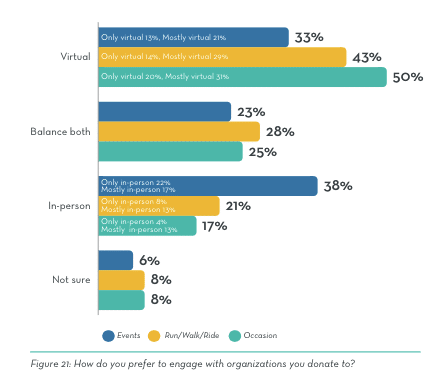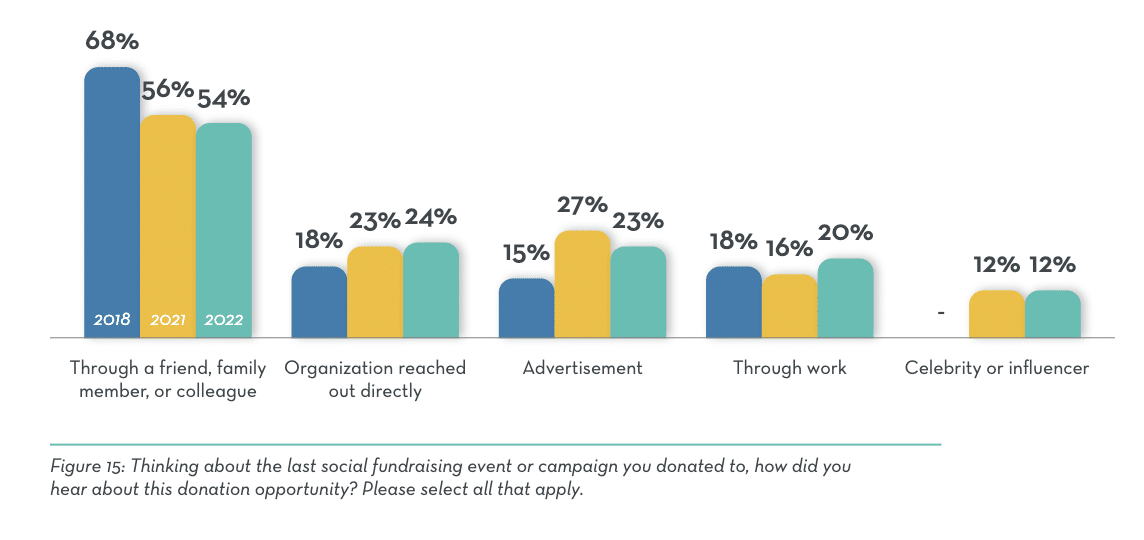In-Person Events are BACK! 4 Tips to Engage Social Donors
As we’ve seen over the past 5 years, fundraising is changing and evolving quickly, especially as we emerge from an extended time of social distancing.
With the world coming back together, how can your nonprofit engage donors who want to return to the ballroom or in-person events, without missing out on those who prefer to engage virtually?
To understand the changing needs of today’s donors, OneCause conducted a recent survey of 1,000+ social donors to understand their giving behaviors, motivators, and expectations on what they need in a fundraising experience. For those curious who social donors are, that’s the name given to supporters who give during ticketed events, occasions, and runs/walks/rides.
According to the 2022 Giving Experience Study, social donors are heading back to the ballroom and face-to-face fundraising, with 74% of survey respondents saying their last giving experience took place in person and 26% reporting they participated virtually.
According to the study, social donors:
- Perceive in-person events as a higher quality giving experience than virtual fundraisers.
- Are more likely to want to participate again next year.
Knowing these facts and giving preferences, it’s a good time for your nonprofit to examine your fundraising calendar. Are you offering in-person experiences as part of your year-round fundraising strategy?
It’s important to note that although social donors prefer in-person fundraising events, they still want the optionality. Meaning they want to choose how and in what ways they want to engage (i.e., virtually or in person). The idea of donor choice, and providing the flexibility in their giving experiences, is impactful to today’s donors.
The level of preference for in-person vs virtual varies by giving type. See the chart below for a breakdown by events, run/walk/ride or occasion donors. The big takeaway is: incorporating optionality in your nonprofit events is critical to attracting donors and to maximize your fundraising success.
Now that you understand the influence and impact your fundraising events on today’s donors, let’s dive into 4 top engagement strategies to maximize participation in your in-person and virtual social fundraising:
1. Give Your Donors Choice & Options
Choice is powerful – offering multiple modes of engagement helps personalize the giving experience for social donors. Across all type of social giving opportunities (events, run/walk/rides, occasions) donors are looking for varied engagement experiences.
Think about it, in real life (IRL) – today’s donors are also today’s consumers. Choice, flexibility, personalization is all part of our everyday experience and expectations. We want the option to choose and select our shopping, eating, entertainment experiences, and the need for optionality in giving is no different.
So what does that mean for your fundraising?
Give your donors the option to decide when, where, and how they give to your cause is key. Close to a quarter of donors prefer to be offered a balance of in-person and virtual events from the nonprofits they choose to engage. So, when building out your yearly fundraising strategy calendar, consider integrating:
- Opportunities for your supporters to gather in-person
- Virtual-only events to provide a different experience to your donor base
- Dual experiences for both virtual and in-person attendees to choose how they connect with the cause
Depending on your event type, it’s also important to tailor engagement activities and opportunities for each audience. When you know how you’re going to structure your event, be sure to leverage these forms of engagement for your attendees:
- For both in-person and virtual donors, they find hearing the impact of their donations and testimonials to be the most engaging. Take time in your event program to highlight how each donation will be used to benefit your cause.
- For virtual supporters only, have interactive experiences like following a lesson or taking a class. Examples your nonprofit could use are hosting a virtual cooking class or yoga session.
- For in-person supporters only, build in time for socializing with other guests to create a sense of community during your fundraising event. This could be as simple as hosting a cocktail hour before your program starts.
Varied and flexible participation options mean donors are free to participate from where they feel most comfortable, creating ease and frictionless giving. Providing multiple engagement types will increase your fundraising impact and engagement.
PRO TIP: Incorporating virtual options alongside your in-person events help increase converge with ease and immediacy and can allow donors to participate with the click of a button.
2. Generate Excitement Around Live Event Results
When it comes to keeping donors engaged at an event, building excitement around live event results can be a simple way to boost donor participation. In fact, 58% of social donors reported viewing live results of competition as the most engaging factor during fundraising events.
To create an exciting atmosphere, consider the following strategies to promote your live event results:
- Host a competition or challenge leading up to your event or gala. This creates buzz leading up to your event and gets attendees excited to be a part of the results at the live event. An easy idea is to recruit local community leaders to compete in a social fundraising challenge online before they compete in a pageant during the event.
- Share testimonials from individuals benefiting from your nonprofit. Personal stories deepen engagement with your mission and connect donors to the impact of their gifts. Sharing these testimonials during your event is a simple way to get participants emotionally linked to your mission and the outcome of your efforts. They are there to support and help, so let them see the work you do, why it matters, and how they can help you reach your goals.
- Include one-click donation options. After sharing your event’s results, encourage guests to donate in real-time with one-click donations. Ease and immediacy are important motivators for today’s donors. Make giving simple and fast, and help your cause get closer to your goals. Be sure to incorporate mobile bidding or online fundraising software for both in-person and virtual attendees.
PRO TIP: Getting attendees excited about real-time fundraising results during your event can drastically boost your event success. Create easy giving experiences to go in tandem with displaying your fundraising goal to get attendees to feel that their donation has a greater impact on the overall fundraising achievement.
3. Create Multichannel Engagement
Each donor engages with your event and cause differently. To reach a wide pool of social donors, be sure to use more than one marketing outlet to boost engagement.
One easy channel to tap into is your donor’s personal networks. More than half of social donors heard about their most recent social giving opportunity through a friend, family member, or colleague.
Giving is very personal and interconnected, so it makes sense that donors are most likely to hear about a nonprofit’s mission through friends and family! Tap into these connections through leveraging Ambassador Fundraising to boost event engagement and get them talking about your cause.
It’s important to arm ambassadors for your mission with templates and technology that make it easy for them to share, thank, and further communicate with donors they engage. Here are a few ideas to keep in mind:
- Sample email templates
- Promotional materials
- Social media recruitment posts
- Social integration from your peer-to-peer technology
- Donation talk tracks or donation solicitation emails
- Automated notifications when a new participant joins the campaign or their team
Outside of Ambassador Fundraising, leverage omni marketing strategies and outlets to generate buzz around your event. The top four channels through which donors learned about their last giving opportunity were social media, in person, email, and a nonprofit’s website.
To ensure you are reaching a wider donor base, connect your fundraising by following these top tips:
- Create an event hashtag or social media competition: Encourage event attendees to post about your cause and fundraising event on social media. This provides a great way for donors to connect online, while boosting the social traction around your page.
- Promote other ways to get involved: Take time during your event to promote alternate ways attendees can engage with your cause. This can include other giving opportunities, to volunteer experiences, or upcoming events This promotion allows you to keep your donors engaged outside just attending one event.
- Send out an email campaign: Leverage your internal donor base to share out your next fundraising event. Create a short email campaign that educates your donors on what they are fundraising for and allows them to donate through the email. Persuasive and impact messaging is important to use to increase the impact of your email fundraising.
- Advertise your fundraising event on your website: If a donor is looking at your site, they are most likely interested in learning more and getting involved with your cause. Use your website homepage as a place to promote your fundraising events and reach donors who are already inclined to give to your cause.
PRO TIP: When creating a marketing strategy to boost your event engagement, be sure to diversify both the channels you’re marketing on and your messaging too. Tailoring your messaging to your specific platform will help you stand out in a noisy and competitive fundraising world.
4.Minimize Pain Points for Donors
Having an easy giving experience maximizes the impact your nonprofit has on donors. For today’s event-focused social donors, 53% reported ease as a key factor for determining whether or not to give a donation. So, how can you streamline your event to make it easy for donors to give?
The first step to creating a seamless donor experience is to map out your event experience for both in-person and virtual donors. This helps you identify any points of friction at which you can make small adjustments to improve the guest experience. Small changes add up! Some adjustments you can make are implementing:
- Contactless check-in
- Multiple ticket options
- Simplified check-out (e.g., self-service check-out, delivery options, or item pick-up windows)
For events with both in-person and virtual attendees, make sure each attendee experience is analyzed to ensure a positive experience for guests on event day.
- For virtual audiences, try having a volunteer run through the registration process and attempt a few tasks like searching for items, placing a bid, etc. Did they run into any issues that could be easily solved? Where did they get stuck?
- For in-person guests, have your event team walk through your venue’s flow and make sure there is enough space and staffing at each guest point of contact. This includes check-in, raffle sales area, and check-out. Were there any points where guests might get confused on where to go next?
- For both virtual and in-person attendees, ensure it is easy to find how to donate, bid, and find event information for each guest type. Minimizing confusion on event day will free up time for your team to focus other things instead of tech questions.
PRO TIP: Have a couple volunteers dedicated to answering and troubleshooting guests’ questions. Set up a help desk or kiosk (all you need is a high-boy table) to quickly answer attendee questions. It’s an easy way to reduce the number of questions the team must address and reduce attendee frustration.







Putting the Data to Work
Now that you have the basics on how to engage social donors, it’s time to think about how to incorporate them into your development strategy. Here are four simple tips your nonprofit can take to create a social donor fundraising plan: